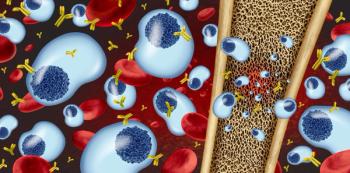
Proactive Dermatologic Care Reduces Symptom Severity and Boosts Quality of Life in NSCLC
Key Takeaways
- COCOON DM significantly reduced grade 2 or greater dermatologic adverse events in EGFR-mutant NSCLC patients compared to standard care.
- The COCOON trial demonstrated improved patient-reported outcomes, including quality of life, with COCOON DM.
Enhanced dermatologic management reduces skin rash and improves quality of life for patients with EGFR-mutant non-small cell lung cancer.
Enhanced dermatologic management (COCOON DM) in combination with amivantamab (Rybrevant; Janssen Biotech, Inc) plus lazertinib (Lazcluze; Janssen Biotech, Inc) significantly reduced the incidence of grade 2 or greater dermatologic adverse events (AEs) compared with standard of care dermatologic management (SoC DM) in patients with EGFR-mutant advanced non–small cell lung cancer (NSCLC). The interim results from the phase 2 COCOON trial (NCT06120140) will be presented at the 2025 ASCO Annual Meeting in Chicago, Illinois.1
Skin and nail changes are commonly associated with various cancer therapies and are often more severe for patients receiving stem cell transplants, targeted therapy, or immunotherapy. Amivantamab, an EGFR-MET bispecific antibody, and lazertinib, a third-generation EGFR tyrosine kinase inhibitor, are independently associated with dermatologic AEs, which can impact a patient’s quality of life. Treatment for dermatologic AEs is typically reactive, consisting of topical/systemic corticosteroids and/or systemic antibiotics. However, emerging data suggest that an enhanced prophylactic management strategy might yield superior clinical outcomes.2,3
COCOON is a phase 2, open-label, randomized trial investigating the benefit of COCOON DM compared with standard dermatologic management (SoC DM) in patients with locally advanced or metastatic EGFR-mutated NSCLC who were treated with first-line amivantamab and lazertinib. The patients (n = 138) were randomized 1:1 to receive either COCOON DM (n = 70) or SoC DM (n = 68). COCOON DM included oral doxycycline/minocycline (100 mg twice daily for weeks 1 through 12), clindamycin 1% lotion on the scalp (once daily for weeks 13 through 52), chlorhexidine 4% to wash hands and feet once daily, and non-comedogenic ceramide-based moisturizer to the body and face once daily. To improve adherence to the DM regimen, the COCOON DM arm was given a digital health tool that included reminders and training on dermatologic AEs.1,4
Dermatologic symptoms and their impact on patients’ health-related quality of life (QoL) were assessed biweekly using patient-reported outcome (PRO) instruments. The Skindex-16 questionnaire evaluates the effect of skin conditions on QoL across 3 subscales—functioning, emotional well-being, and symptoms—and provides an average score ranging from 0 (no effect) to 100 (constant effect). The Patient’s Global Impression of Severity (PGI-S) is a self-reported, 4-point scale used to rate the severity of nail infections, skin conditions, and rashes over time (no symptoms, mild, moderate, severe). This analysis focuses on patient-reported outcomes through the first 12 weeks of treatment, corresponding to three 28-day cycles of amivantamab and lazertinib therapy.4
By week 12 (median follow-up: 4.2 months), COCOON DM consistently showed a favorable separation compared with SoC DM, indicating lower severity of dermatologic AEs and less impact on quality of life. By cycle 3, day 15 (~10 weeks), the average Skindex total score was significantly lower in the COCOON DM arm compared with SoC DM (P = .02).4
A greater proportion of patients in the COCOON DM group also reported mild or no symptoms for rash, skin condition, or nail infection on the PGI-S across all 3 treatment cycles. At cycle 3 day 15, there was a notable 3-fold increase in the percentage of patients reporting no symptoms for PGI-S rash (21% vs 7%; P = .04) and skin condition (23% vs 7%; P = .02) with COCOON DM vs SoC DM. A numerical improvement was also observed for nail infections (27% vs 16%; P = .13).4
The interim data highlight the superior benefit of COCOON DM over SoC DM in reducing dermatologic AM severity, supporting its continued study and potential implementation in clinical practice.
REFERENCES
1. Enhanced dermatological care to reduce rash and paronychia in epidermal growth factor receptor (EGRF)-mutated non-small cell lung cancer (NSCLC) treated first-line with amivantamab plus lazertinib (COCOON). Updated April 29, 2025. Accessed May 29, 2025. https://clinicaltrials.gov/study/NCT06120140
2. Skin and nail changes during cancer treatment. National Cancer Institute. December 29, 2022. Accessed May 29, 2025. https://www.cancer.gov/about-cancer/treatment/side-effects/skin-nail-changes
3. Cho B, Girard N, Sauder M, et al. P3.12D.04 Enhanced vs standard dermatologic management with amivantamab-lazertinib in advanced NSCLC: Phase 2 COCOON Study. Journal of Thoracic Oncology. October 2024. doi: 10.1016/j.jtho.2024.09.626
4. Feldman J, Cho B, Li W, et al. Dermatologic prophylaxis and impact on patient-reported outcomes in first-line EGFR-mutant advanced NSCLC treated with amivantamab plus lazertinib: Results from the phase 2 COCOON trial. 2025 ASCO Annual Meeting. May 30. 2025, to June 3, 2025. Chicago, IL. Abstract 8641
Newsletter
Stay informed on drug updates, treatment guidelines, and pharmacy practice trends—subscribe to Pharmacy Times for weekly clinical insights.




















































































































































































































